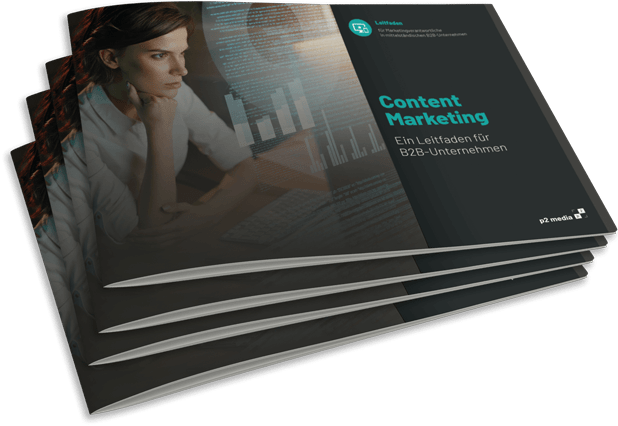The primary goal of inbound marketing is to arouse the interest of potential customers, at best to inspire them and thus get the chance to interact with them. In order to achieve this with maximum success, i.e. an ultimate conclusion and long-term business relationships, nowadays not only absolutely unique, beneficial content must be created and the technical requirements must be right. It is also essential to use all available channels and to record the results of the efforts in figures.
The focus here is on the appropriate B2B content marketing strategy, because without appealing texts, images, graphics, videos, etc., all the other processes just listed practically do not take place. It is also important to include the behaviour of the (potential) customer on the web in the content strategy in order to be able to stage content optimally.
What this means exactly, why the content marketing strategy is so relevant today in B2B competition, what requirements it brings or entails and much more, you can read in this article.
The advantages of content marketing
Contemporary B2B content marketing never gives the impression to the potential customer that it is primarily intended to sell. If this is not the case, it is "classic" advertising, which never achieves the specific benefits that the strategic development and placement of web content can yield.
Today, the user and his experience should be completely at the center of efforts. Only content that is precisely geared to the user is actually able to convince. If content offers added value, not only will it be remembered, but also the company behind it. Remember that (potential) customers are primarily looking for solutions to problems and not for concrete products. If you help them with this, i.e. provide orientation, you will be rewarded as a problem solver with a lasting positive impression. Website users can, of course, only be truly inspired with high-quality content. The latter must include all the information they are looking for and, at best, reveal facts on top of it. If a real added value is conveyed, the chance is very high that the content provider, achieves a deal and is rewarded with a long-term positive impression.
But Google and co. also recognize quality. Since today in B2B a large part of the marketing processes takes place online and the target groups often become aware of corresponding solutions via search engines (SEO), optimal content should also be relied on in terms of findability.
Especially in terms of long-term ranking success, high-quality content is highly relevant. Search engines measure, among other things, how long users stay on a website. Keywords, data structures, backlinks, etc. can be perfectly coordinated - if a website does not convince its users with the quality of its content, i.e. cannot persuade them to stay, it will still be downgraded sooner or later.
In fact, content quality is now one of the most important ranking factors and so should be central to any content marketing strategy. It's best to always ask yourself how you can meet your (potential) customer's expectations as comprehensively as possible.
Why content marketing has a lasting effect
With an optimally developed content strategy, you can create alasting impression on your (potential) customers. Creating solutions and orientation are the keys to effective content marketing. At best, you create real added value and entertain your viewers in the process. Basically, this can be summed up in three steps. If you have these in mind for your content marketing, the conditions are good that your content strategy will work and be effective in the long run.
First, you need to attract prospects. Textbook static advertising messages won't get you very far here for a long time. Today, highly successful content strategies are almost always built on stories that users can identify with. When content appears organic and personal, and when the information and presentation appear to be tailored to the needs of the viewer, positive emotions are automatically generated. It is important to note that good content does not always have to refer to a specific product or service of the company. Even the skilful implementation of industry newsor general guides on company-relevant topics can contribute to the success of your content marketing strategy.
The viewer should be picked up within the content marketing strategy with interesting stories and information packed in it, which help him solve his problem and perhaps beyond. If this is successful, he will most likely contact you or buy a suitable product or service. If the customer journey runs optimally, the customer will also remain loyal to the problem-solving company in the future. However, to support loyalty, continue to focus on a value-added content marketing strategy. So offer relevant content on a regular basis.
The Customer Journey and User Experience
The customer journey usually begins in the mind of the potential customer. The customer is looking for a solution to a problem and nowadays usually starts with Google and Co. to get help. The first three, maybe five results are first viewed superficially. If content stands out particularly positively at first glance, it will probably be looked at a little deeper. The following also applies to B2B content strategy: The first impression counts! For a promptly convincing appearance, the content marketing as such must be right. However, this involves much more than providing optimally fitting information. The presentation is also absolutely important. Slow loading pages, unbalanced color schemes, the unfavorable display on mobile devices or too much continuous text - these are all factors that do not primarily reduce the quality of the information provided, but are (often unconsciously) negatively perceived by users. This in turn leads to a drop-off and the loss of the opportunity to convince with the content marketing strategy. A good B2B content marketing strategy takes into account all factors that Customer Journey influence and thus contribute to a positive user experience. If, during the course of the journey, it turns out that several companies offer potentially useful content, they will be compared. The one that ultimately drives the best content strategy, i.e. provides the content with the highest potential for trust and the clearest added value, will most likely be rewarded with a deal and perhaps a long-term commitment. A content marketing strategy is only successful if the relevant content is actually getting noticed. The appropriate alignment with the ranking factors of the major search engines is quite central here. However, it must also be taken into account in the content marketing strategy in which phase of the customer journey the target group prefer to use which channels. So strategically distribute your content across the channels that are relevant to you. There are basically three types: paid ads, your own channels such as newsletters, blogs and social media and the so-called earned channels, i.e. recommendations from other places.
Content Marketing Strategien
It is important to note that in content marketing, the interpretation processes on the viewer's side often do not take place superficially, but have a subconscious effect. It is not enough to provide exactly the information that the users of a website expect. This information must also be provided in optimally aligned structures, designs, on specific media and as suitable content types.
Personas help determine how best to align your B2B content marketing strategy. Being aware of a specific target group in content marketing is good. However, eliciting personas gives you even more differentiated clues as to how you can work on the needs of the (potential) customer. In contrast to target group marketing, persona marketing specifically involves how a fictitious person can be helped with their problems and challenges. Focus your B2B content strategy on these and other facts and assumptions. Ask yourself how you can best support your personas and also in what form you present the arguments.
The customer journey also provides useful clues for the content strategy. So optimally align content so that your (potential) customers or personas get the most useful content for you at each of the journey stages - attention, interest, consideration, closure. The question here is: What interests who at which stage of the customer journey.
Furthermore, you should think carefully about which touch points you determine in your B2B content marketing strategy. It is important to find out what actions the respective concerns of your personas entail and whether this might result in an opportunity to get in touch. So, for example, ask yourself what a (potential) customer might search for on Google regarding a problem solution you offer. If you deal with search engine optimization of websites, possible touchpoints could be search queries about loading times or link building, among others.
Of course, you should not just write and then see whether the content is accepted. A good content marketing strategy deals with the question before the realization of texts, videos, etc. : What topics are my personas particularly interested in? In addition to the added value, the premise of uniqueness should always be considered.
Furthermore, for a content strategy to be as successful as possible, it is important to know what types of content already exist for your company's main focus. Be careful not to repeat everything again - set unique selling points through your very own B2B content marketing. But don't go too far out of the box either, in order to be able to satisfy the expectations of your personas.
In order to successfully implement and optimize your content strategy and thus your B2B content marketing in the long term, you need key performance indicators - the so-called KPIs. Based on these, you align future actions. You determine which KPIs are relevant for your company. There is no universal approach here that applies to every content marketing strategy. However, you can never go wrong with monitoring website visitors, their dwell time, the number of newsletter subscribers, if applicable, and successful conversions.
What are the IT and SEO requirements?
As a rule, customers today become aware of the services of a B2B company via search engines. This has been a fact for quite some time. So whoever invests in search engine optimization is automatically ahead, right? Unfortunately, this is not necessarily true. Because B2B content marketing has long since ceased to be synonymous with SEO. The search engines are increasingly working against blunt placement strategies around floods of keywords etc.. Accordingly, it is by no means sufficient to rely entirely on static SEO measures in the content marketing strategy in order to achieve a good ranking. The quality of the content is becoming more and more important. Nevertheless, the "classic" SEO is still absolutely necessary. However, it should not stand apart from content strategy as a stand-alone success factor, but should be carried out in suitable cooperation with content marketing. If you take this into account, you can achieve a lot with the right keywords, internal and external links, backlinks, etc. as well as IT-relevant SEO measures, such as fast servers or pagespeed improvements or a good mobile quality.
Our support around the topic of content marketing:
- Together with you, we develop a custom-fitcontent marketing strategy. Everything revolves around your specific target group.
- We are also happy to take on thecreation of relevant and target group-compliant content along the entire costumer journey of your target group.
- Oursearch engine-compliant refinement ofthe content improves your ranking and thus your visibility among potential customers.
- If desired, we also take over theContent refinementin various content management systems and web applications such as apps or third-party platforms.
For holistic and successful online marketing, we are also happy to take care of the following topics:
Oliver Parrizas will be happy to answer any questions you may have on the subject. +49-800-911-91-91











